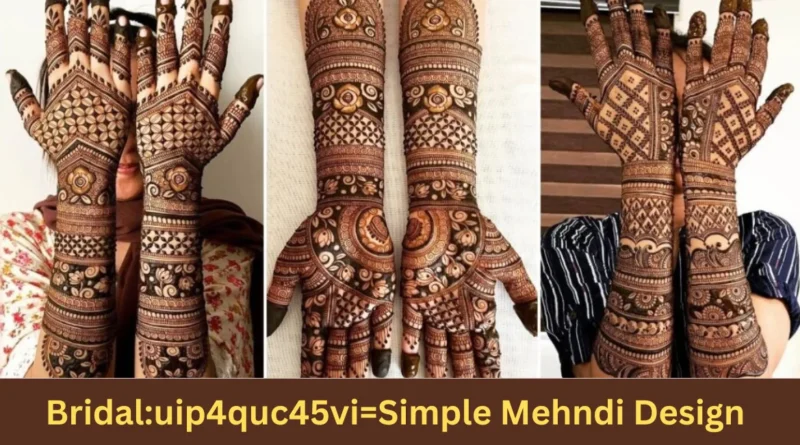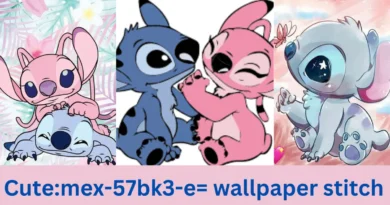Bridal:uip4quc45vi=Simple Mehndi Design: A Comprehensive Guide for the Modern Bride
Mehndi, also known as henna, is an ancient art form that has been a part of wedding traditions for centuries. Its intricate patterns and deep cultural significance make it a beloved ritual in many cultures, especially in South Asia. For brides, mehndi is not just a decorative element but a symbol of love and new beginnings. In this comprehensive guide, we delve into the world of simple mehndi designs that are perfect for the modern bride.
What is Bridal:uip4quc45vi= Simple Mehndi Design
A Simple bridal mehndi design, or henna design, is an essential part of Indian, Pakistani, and other South Asian wedding traditions. Mehndi involves creating intricate, temporary designs on the bride’s hands and feet using a paste made from the powdered leaves of the henna plant. Simple mehndi designs can be just as beautiful and meaningful as more elaborate ones. Here are some characteristics and tips for simple bridal mehndi designs:
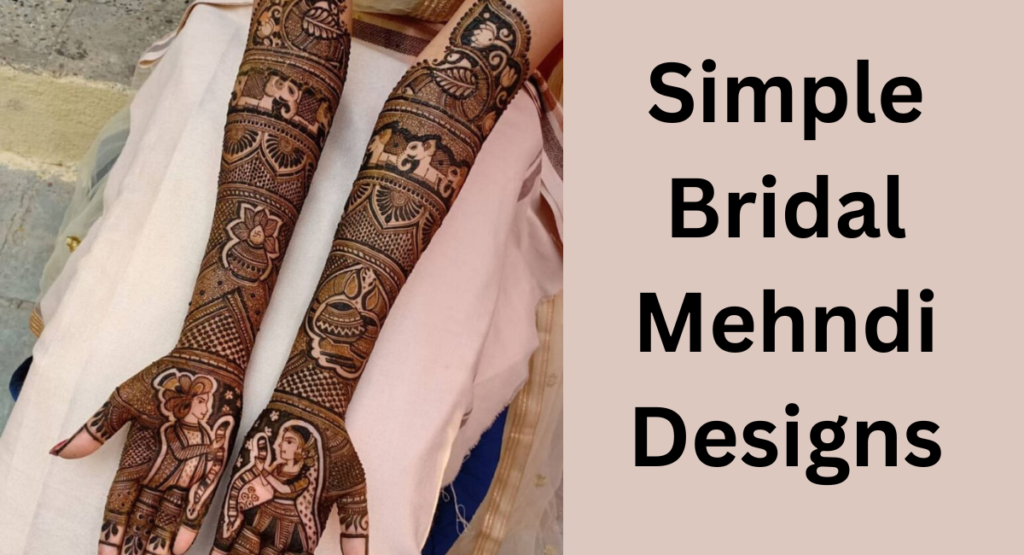
Characteristics of Simple Bridal Mehndi Designs:
- Minimalistic Patterns: Simple designs often feature minimalistic patterns, focusing on elegance and sophistication. Common motifs include flowers, leaves, and geometric shapes.
- Clean Lines: The lines in simple mehndi designs are clean and precise. This can be achieved with a steady hand and careful attention to detail.
- Small Focal Points: Instead of covering the entire hand or foot, simple designs often have small focal points, such as a flower on the palm or a mandala on the back of the hand.
- Symmetry: Simple designs often maintain symmetry, especially when applied to both hands or both feet. Symmetrical patterns are aesthetically pleasing and easy to create.
- Negative Space: Utilizing negative space effectively can enhance the simplicity and elegance of the design. Leaving parts of the skin exposed can create a beautiful contrast with the henna.
Tips for Creating Simple Bridal Mehndi Designs:
- Start with a Base Design: Begin with a simple base design, such as a central flower or mandala, and then add smaller elements around it.
- Practice Precision: Simple designs rely heavily on the precision of the lines and patterns. Practice creating clean, even lines.
- Use Reference Images: Look at reference images of simple mehndi designs for inspiration. You can find a variety of styles that fit the simple and elegant theme.
- Experiment with Placement: Try placing designs on different parts of the hand or foot. A small, intricate design on the finger or the side of the hand can be striking.
- Focus on Quality over Quantity: Instead of filling the space with many elements, focus on the quality and beauty of each element you include.
Simple bridal mehndi designs can be a beautiful and elegant choice for a bride, offering a timeless and sophisticated look on her special day.
Also Read: Amazon Project kuiperalamalhodaitechcrunch | Crane Rental Prices | Musaris Login
Why Choose Simple Mehndi Designs?
Elegance and Sophistication
Simple mehndi designs are known for their elegance and sophistication. They are perfect for brides who prefer a minimalist look. These designs focus on clean lines and subtle patterns, creating a graceful and refined appearance.
Time-Saving
Compared to elaborate designs, simple mehndi patterns are quicker to apply. This is particularly beneficial for brides who have a packed schedule leading up to the wedding day. It ensures that the mehndi application process is stress-free and enjoyable.
Versatility
Simple mehndi designs are incredibly versatile. They can be easily customized to suit the bride’s preferences and the overall theme of the wedding. Whether you prefer floral patterns, geometric shapes, or traditional motifs, simple mehndi designs can be adapted to reflect your unique style.
Popular Simple Mehndi Designs for Brides
Here are some popular simple mehndi designs for brides

Floral Patterns
Floral mehndi designs are timeless and classic. They symbolize beauty, femininity, and nature. These designs typically feature delicate flowers, leaves, and vines that create a beautiful and cohesive pattern. Floral designs can be placed on the palms, back of the hands, and feet, making them a versatile choice for any bride.
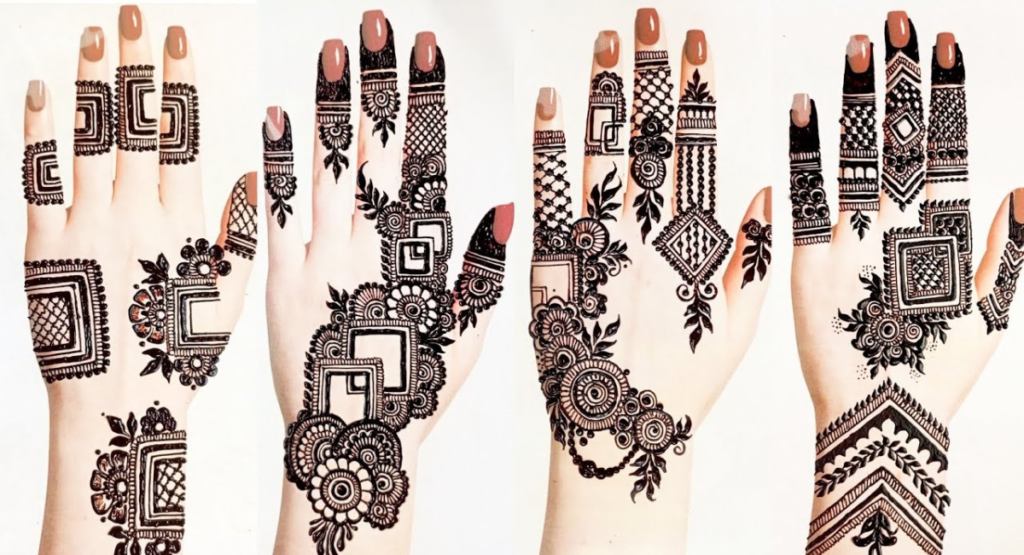
Geometric Patterns
Geometric mehndi designs are perfect for brides who love modern and contemporary styles. These designs incorporate shapes like circles, triangles, and squares to create intricate and eye-catching patterns. Geometric designs are not only stylish but also provide a unique twist to traditional mehndi art.
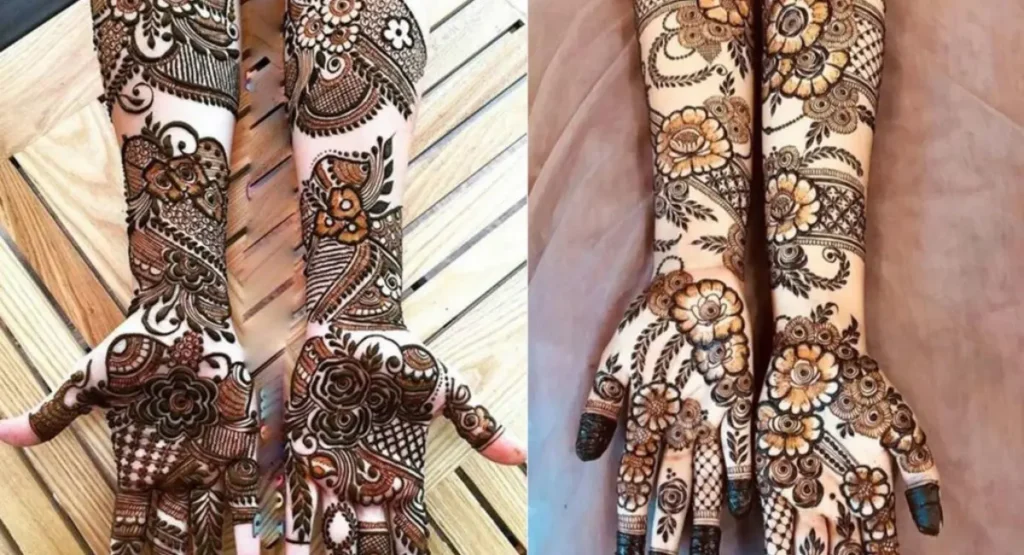
Arabic Mehndi Designs
Arabic mehndi designs are known for their bold and striking patterns. Unlike traditional Indian mehndi, which covers the entire hand, Arabic designs often feature larger motifs with more negative space. This style is ideal for brides who want a dramatic and elegant look.
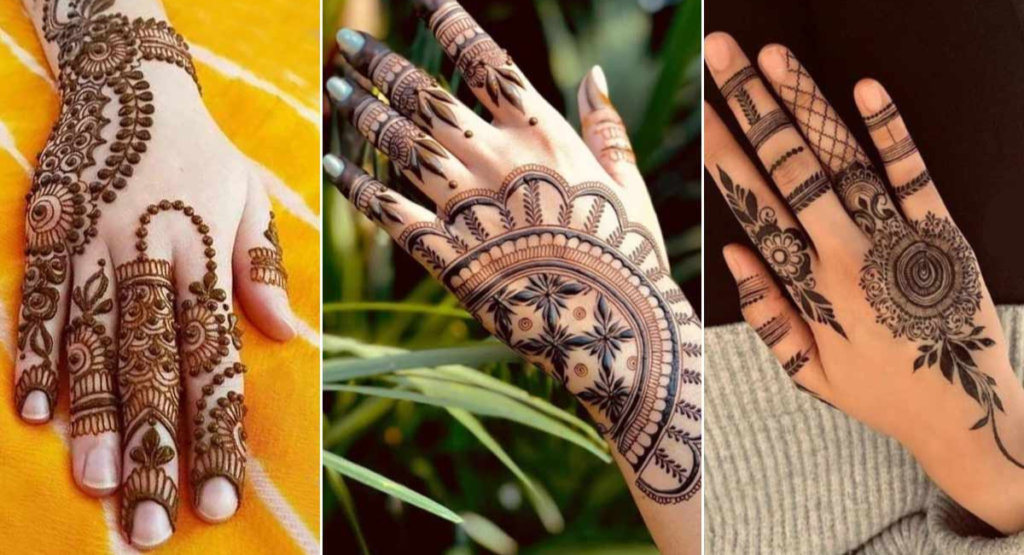
Minimalist Designs
Minimalist mehndi designs focus on simplicity and subtlety. These designs often feature small, delicate motifs that are strategically placed to enhance the bride’s natural beauty. Minimalist mehndi is perfect for brides who prefer a less-is-more approach to their wedding day look.
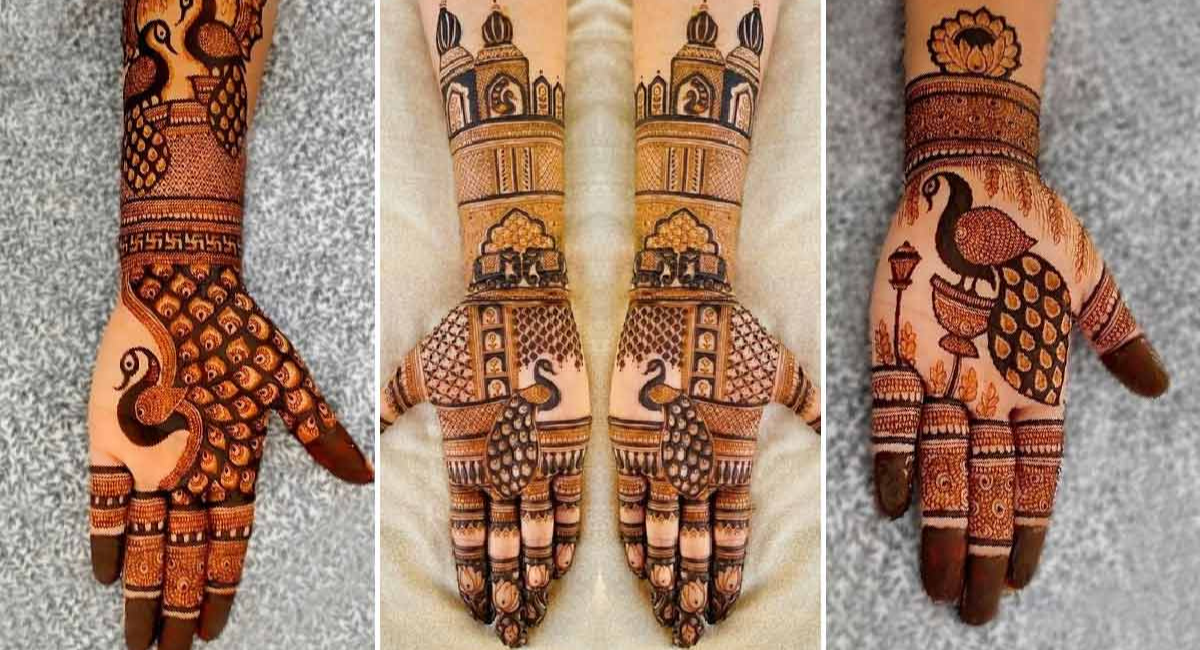
Peacock Mehendi Design
For brides who love classic designs, the peacock mehendi design is a timeless choice. Placing the peacock in the middle of the hands and adding intricate patterns to its feathers creates a stunning look.
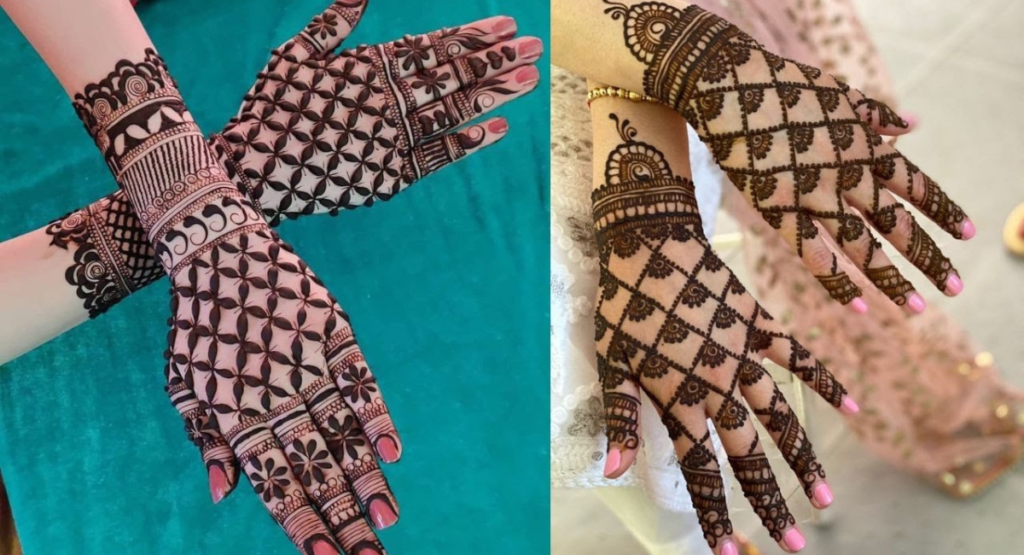
Jaal Mehendi Design
Jaal mehendi designs are ideal for brides and are perfect for the festive seasons. The symmetric designs on the palms make them look traditional and trendy, and the versatility of this pattern can highlight even the feet. This design has been a popular choice for many brides and is here to stay
Tips for Choosing the Perfect Mehndi Design
Consider Your Personal Style
Your mehndi design should reflect your personal style and taste. Whether you prefer traditional or modern designs, make sure the pattern you choose resonates with you and complements your wedding attire.
Think About the Wedding Theme
The mehndi design should align with the overall theme of your wedding. For example, if you are having a traditional wedding, you might opt for classic Indian mehndi designs. For a contemporary wedding, geometric or minimalist designs might be more suitable.
Consult with a Professional Mehndi Artist
A professional mehndi artist can help you choose and customize the perfect design. They have the expertise and experience to create intricate patterns that will look stunning on your wedding day. Don’t hesitate to share your ideas and preferences with them to ensure you get the mehndi design of your dreams.
Also Read : Showbizztoday.com | Affordable SEO Melbourne AppKod | Your Organization’s Data Cannot Be Pasted Here -policy
How to Care for Your Mehndi
Pre-Application Care
- Exfoliate: Before applying mehndi, exfoliate your hands and feet to remove any dead skin. This helps the mehndi to adhere better and results in a darker stain.
- Avoid Lotion: Ensure your skin is free of any oils or lotions as they can create a barrier and prevent the mehndi from staining properly.
Post-Application Care
- Let it Dry: Allow the mehndi to dry completely. This can take a few hours, so be patient and avoid touching the design.
- Use Lemon and Sugar: Applying a mixture of lemon juice and sugar to the dry mehndi helps to enhance the color. The sugar keeps the mehndi in place while the lemon juice acts as a natural dye.
- Keep it Warm: Heat can intensify the color of the mehndi. You can use a heating pad or sit near a heater to help the color develop.
- Avoid Water: After removing the mehndi paste, avoid washing your hands with water for at least 12 hours to allow the color to deepen.
Conclusion
Choosing the right mehndi design is an essential part of the bridal preparation process. Simple mehndi designs offer a perfect blend of elegance, sophistication, and versatility, making them a popular choice for modern brides. By considering your personal style, wedding theme, and consulting with a professional mehndi artist, you can ensure that your mehndi is both beautiful and meaningful.
Frequently Asked Question
Q1: What is Mehndi, and why is it important for brides?
A1: Mehndi, also known as henna, is a traditional art form that involves applying intricate designs on the skin using a paste made from the leaves of the henna plant. For brides, Mehndi is significant as it symbolizes joy, beauty, and auspiciousness. It’s often seen as a way to enhance the bride’s beauty on her special day and is a cherished part of wedding rituals in many cultures.
Q2: What are some popular simple Mehndi designs for modern brides?
A2: Simple Mehndi designs that are trending for modern brides include minimalist floral patterns, delicate lace motifs, geometric shapes, and tiny mandalas. These designs often focus on clean lines and understated elegance, making them perfect for brides who prefer a more contemporary look.
Q3: How can a bride choose the right Mehndi design for her personality?
A3: A bride should consider her personal style and preferences when selecting a Mehndi design. If she loves intricate details, she might opt for designs with elaborate patterns. Conversely, if she prefers a clean and modern aesthetic, simple floral or geometric designs would be ideal. It can also help to look at inspiration from various sources, such as social media or bridal magazines.
Q4: What should a bride consider when choosing a Mehndi artist?
A4: When choosing a Mehndi artist, a bride should look for someone with experience and a portfolio that reflects her desired style. Recommendations from friends or family can be invaluable. Additionally, it’s essential to discuss the artist’s hygiene practices, the quality of the henna used, and any allergies or sensitivities with the bride.
Q5: Can Mehndi be applied on other parts of the body besides the hands and feet?
A5: Yes, Mehndi can be applied to various parts of the body, including the arms, back, and even on hair. Some modern brides choose to have Mehndi designs on their shoulders, neck, or even in unique placements like their fingers or behind their ears, allowing for a personalized touch.
Q6: How can a bride prepare her skin for Mehndi application?
A6: To prepare her skin for Mehndi, a bride should exfoliate the areas where she plans to apply the design, ensuring it’s clean and free of oils or lotions. Keeping the skin moisturized in the days leading up to the application can also help the Mehndi adhere better and result in a richer color.
Q7: Are there any cultural variations in Simple Mehndi designs?
A7: Yes, there are numerous cultural variations in simple Mehndi designs. For example, Indian Mehndi often features intricate patterns and motifs, while Arabic Mehndi tends to be more bold and floral. Pakistani Mehndi combines elements from both styles and often includes personal stories in the designs. Each culture brings its own significance and artistry to the Mehndi tradition, making it a diverse and rich practice.
